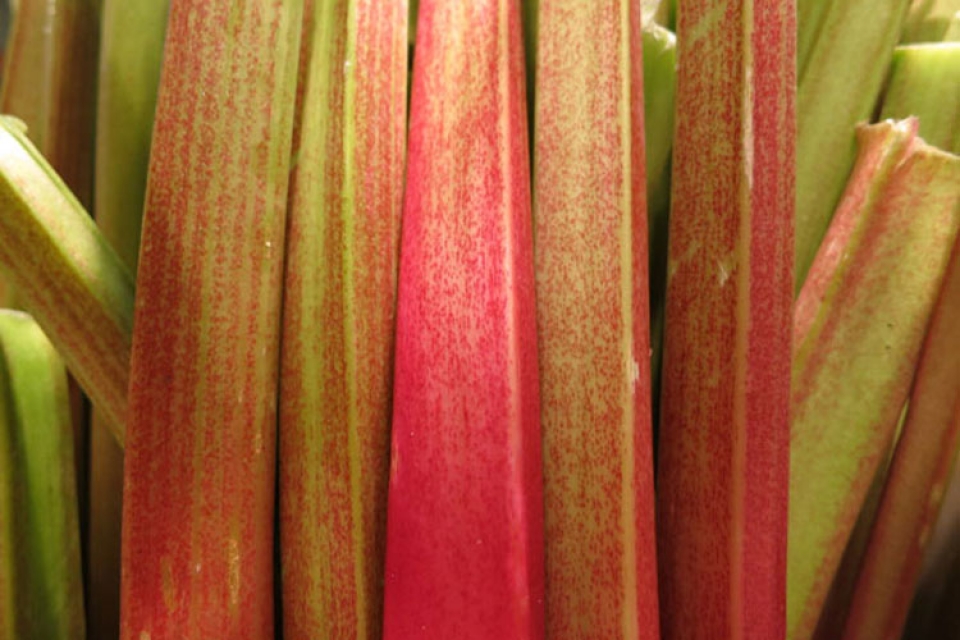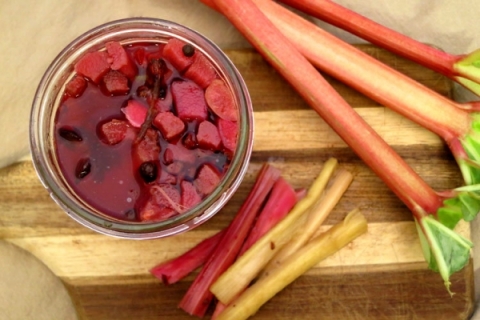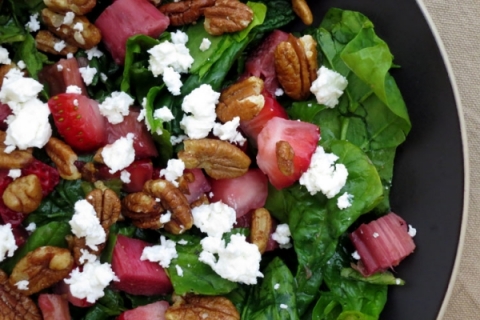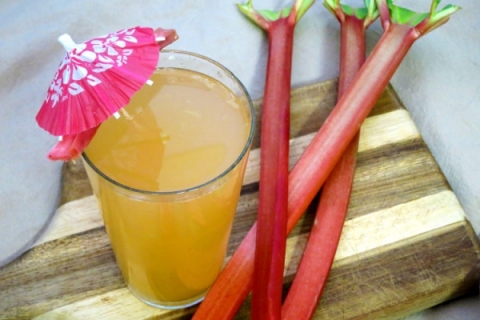Stocking Spring Stalks: Rhubarb!
While excited about the arrival of spring produce, I have to admit I feel a little burned out on the same ‘ole recipes. When I think of rhubarb, I think of strawberry rhubarb pie, or compote, or chutney. If you search online, you are likely to find hundreds, or even thousands, of versions of the same recipe. It’s time to switch it up a little and get more adventurous with rhubarb!
Because of the tartness of rhubarb, it is appealing to balance it with sweetness and serve it as a dessert. I was interested in finding other ways to cook it and was really excited to see some new ideas published in Eating Well magazine: Rhubarb Pickles and Roasted Rhubarb Salad! These recipes, and more, can be found below. Talking to our Produce Buyer, Kara Brown, I learned of another interesting way to use rhubarb, and her personal favorite: Fried Rhubarb Peanut Butter and Jam Sandwiches. For this recipe, you’ll have to attend our Cooking with Rhubarb class this month.
My search turned up some interesting beverage ideas too, like a Vermont Spring Tonic, found in the Cooking with Shelburne Farms cookbook. There’s also the idea of adding frozen rhubarb to smoothies. Or better yet, puréeing rhubarb to enjoy in a margarita, yum!
Something else new (or old, rather) about rhubarb - I read in Asparagus to Zucchini: A Guide to Farm Fresh Seasonal Produce that use of rhubarb originated in China 4,000 years ago, where it was used as medicine. Having studied plants much of my life, this didn’t ring a bell at first, but then I came across the Neutralizing Cordial recipe online. I remembered that this tincture can soothe a variety of digestive complaints.
Nutritionally, rhubarb is low in saturated fat and sodium and is cholesterol-free. It is a good source of magnesium, fiber, vitamin C, vitamin K, calcium, potassium and manganese. One cup of raw rhubarb contains 105 mg of calcium, which is about 10 percent of the recommended daily allowance (RDA) of calcium for adults, ages 19-50. It is also loaded with lutein, which is great for the eyes and skin, and many other beneficial antioxidants.
Interested in trying one of the recipes mentioned above or a new one that you found yourself? Choose crisp, firm, darkly colored stalks. To store rhubarb, wrap it in a damp towel or store it in a plastic bag for up to one week. To store rhubarb longer, wash, chop and freeze it. While rhubarb may have medicinal and nutritional benefits, it is important to note that the roots and leaves are toxic, due to high levels of oxalic acid! Only the stalks are edible.
As you can see, with the internet at our fingertips, it is simple enough to find new inspiration when in a pinch. Watching the progression of new produce come and go is such an amazing sight, definitely worth capturing and appreciating to its fullest. With recipes new and old, I hope that you will take full advantage of the opportunity to indulge.
Recipes
Pickled Rhubarb
Recipe from Eating Well: March/April 2015
1 tsp. allspice berries
1 tsp. juniper berries
1 tsp. coriander seeds
½ tsp. whole black peppercorns
2 chilies de arbol
1 shallot, halved
2 small bay leaves
2 star anise
1 cup rice vinegar
1 cup water
½ cup plus 1 tablespoon sugar
1 tsp. kosher salt
1¼ pounds trimmed fresh rhubarb stalks
1. In a mortar and pestle, lightly crush juniper, allspice, coriander and peppercorns. Place crushed spices in a medium saucepan and add chilies, shallot, bay leaves, star anise, vinegar, water, sugar and salt. Bring to a boil. Reduce heat to a gentle simmer and cook for 5 minutes, stirring occasionally.
2. If the skin on your rhubarb is at all tough, peel the outermost layer, using your fingernails or a paring knife. Then, cut the rhubarb into 4-inch lengths, so it’s about 1 inch shorter than your jars when upright. If the stalks are thick, halve or quarter them lengthwise so they are about ¾ inch thick.
3. Pack the rhubarb snugly into 2 clean 1-pint canning jars.
4. Fill the jars with the hot liquid and spices. Cover the jars and refrigerate for at least 1 week to 2 months, before eating.
Roasted Rhubarb and Strawberry Salad
This salad, adapted from a recipe published in Eating Well magazine, uses the popular strawberry- rhubarb combo in a new way. Use local rhubarb, strawberries, spinach and goat cheese when possible!
2 ½ cups fresh rhubarb, ½ inch pieces
1 cup fresh strawberries, sliced
2 Tbsp. sugar
¼ cup maple glazed pecans
2 Tbsp. balsamic vinegar
1 Tbsp. olive oil
¼ tsp. salt
¼ tsp. freshly ground pepper
8 cups fresh spinach
½ cup crumbled goat cheese
1. Preheat oven to 450°F. Toss rhubarb with sugar in a medium bowl until well coated; let stand, stirring once or twice, for about 10 minutes. Spread in an even layer on a rimmed baking sheet. Roast until just beginning to soften, about 5 minutes. Let cool for about 10 minutes.
2. Meanwhile, make the dressing by whisk vinegar, oil, salt and pepper together in a large bowl. Add greens; toss to coat with the dressing.
3. Divide the spinach among 4 plates. Top with the rhubarb, strawberries, goat cheese and maple glazed pecans.
Recipe adapted from Eating Well: May/June 2011
A Vermont Spring Tonic: Rhubarb-Citrus Soda
Recipe by Honey Gardens Apiaries, published in Cooking with Shelburne Farms
4 cups rhubarb (about 1 pound)
6 cups of water
1 cup freshly squeezed orange juice
½ cup freshly squeezed lemon juice
1 cup honey
2 quarts plain seltzer
1. Place rhubarb in a large pot and cover with 6 cups of water. Bring to a boil. Reduce heat, cover and simmer for twenty minutes.
2. Pour citrus juices and honey into a large vessel (64 oz. or larger). Pour rhubarb through strainer into the container, pressing the rhubarb to release all of its juices.
3. Whisk to dissolve the honey. Taste and add more honey if desired. Keep in mind that this will eventually be diluted with seltzer.
4. Refrigerate in a sealed container. To serve, pour the rhubarb beverage into a glass and add equal parts seltzer. The base may be refrigerated for up to one month.
Sources:
Gambino, Megan. “Five Ways to Eat Rhubarb.” Smithsonian. July 2011. Web.
“Healthy Recipes for Rhubarb.” EatingWell. 2015. Web.
Madison Area Community Supported Agriculture Coalition. From Asparagus to Zucchini: A Guide to Farm Fresh Seasonal Produce. 3rd ed., Madison: Jones Books, WI 2004. Print.
Pasanen, Melissa and Rick Gencarelli. Cooking with Shelburne Farms. New York: Penguin Books, 2007. Print.
“Raw Rhubarb.” Nutritondata.com, 2014. Web.
“The Health Benefits of Rhubarb.” Livestrong.com. 2015. Web.



